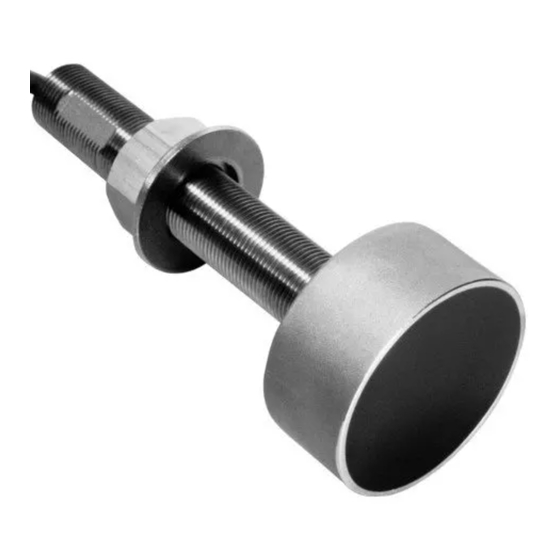
Table of Contents
Advertisement
Quick Links
OWNER'S GUIDE & INSTALLATION INSTRUCTIONS
Thru-Hull
: Stem, NO Fairing
Models: SS422, SS502, SS522
Patent http://www.airmar.com/patent.html
Follow the precautions below for optimal
product performance and to reduce the risk of
property damage, personal injury, and/or death.
WARNING: Always wear safety glasses, a dust mask,
and ear protection when installing.
WARNING: Immediately check for leaks when the
boat is placed in the water. Do not leave the boat
unchecked for more than three hours. Even a small
leak may allow considerable water to accumulate.
CAUTION: Always operate the transducer in water.
Operating in air will allow the transducer to overheat
possibly resulting in failure.
CAUTION: The stainless steel housing must be isolated
from a metal hull to prevent electrolytic corrosion. Use
the isolation sleeve and washers supplied.
CAUTION: SS422, SS522—The transducer must be
oriented properly. The mark on the face must be
forward and parallel to the centerline of the boat.
CAUTION: Never install a metal transducer in a
vessel with a positive ground system.
CAUTION: Never pull, carry, or hold the transducer by
the cable as this may sever internal connections.
CAUTION: Never strike the transducer.
CAUTION: Never use solvents. Cleaner, fuel, sealant,
paint, and other products may contain solvents that can
damage plastic parts, especially the transducer's face.
CAUTION: Never power sand or pressure wash the
sensor. It may weaken the structure or damage the
internal parts.
IMPORTANT: Read the instructions completely
before proceeding with the installation. These
instructions supersede any other instructions in your
instrument manual if they differ.
Applications
Stainless steel transducer compatible with all hull materials.
Recommended for aluminum hulls to prevent electrolytic corrosion
provided the stainless steel transducer is isolated from the metal hull.
Depth Transducer
with Temperature Sensor
Record the information found on the cable tag for future reference.
Part No.________________Date___________Frequency_________kHz
SS502
Tools & Materials
Safety glasses
Dust mask
Ear protection
Permanent marker
Electric drill
Drill bits and hole saws:
Pilot hole
SS502
SS422, SS522
Sandpaper
Mild household detergent or weak solvent (such as alcohol)
File (installation in a metal hull)
Marine sealant (suitable for below waterline)
Knife or scissors (installation in a metal hull)
Slip-joint pliers
Grommet(s) (some installations)
Cable ties
Water-based anti-fouling coating (mandatory in salt water)
Installation In A Cored Fiberglass Hull (page 4):
Hole saw for hull interior:
Cylinder, wax, tape, and casting epoxy
Mounting Location
Guidelines
CAUTION: Do not mount in line with or near water intake or
discharge openings or behind strakes, struts, fittings, or hull
irregularities that will disturb the water flow.
CAUTION: Do not mount the sensor where the boat may be
supported during trailering, launching, hauling, or storage to avoid
damaging the transducer's face.
• The water flowing under the hull must be smooth with a
minimum of bubbles and turbulence (especially at high speeds).
• The transducer must be continuously immersed in water.
• The transducer beam must be unobstructed by the keel or
propeller shaft(s).
• Choose a location away from interference caused by power and
radiation sources such as: the propeller(s) and shaft(s),
machinery, other echosounders, and other cables. The lower
the noise level, the higher the echosounder gain setting that
can be used.
• Choose a location with a minimal deadrise angle.
• Choose an accessible spot inside the vessel with adequate
space for the height of the stem and tightening the nut.
3mm or 1/8" Ø
23mm or 15/16" Ø
25mm or 1" Ø
35mm or 1-3/8" Ø
Advertisement
Table of Contents

Summary of Contents for Airmar SS422
- Page 1 Marine sealant (suitable for below waterline) the isolation sleeve and washers supplied. Knife or scissors (installation in a metal hull) Slip-joint pliers CAUTION: SS422, SS522—The transducer must be Grommet(s) (some installations) oriented properly. The mark on the face must be Cable ties forward and parallel to the centerline of the boat.
- Page 2 SS422, SS522—Orient the transducer, so the mark on the face contact with the water at high speeds. The side of the hull where and the corresponding mark on the stem are forward and the propeller blades are moving downward is preferred.
- Page 3 If the cable must be cut and spliced, use readily observed. Do not leave the boat in the water for more than Airmar’s splash-proof Junction Box No. 33-035 and follow the 3 hours before checking it again. If there is a small leak, there may instructions supplied.
- Page 4 Reapply anti-fouling coating every 6 months or at the beginning of each boating season. 35 Meadowbrook Drive, Milford, New Hampshire 03055-4613, USA • www.airmar.com Copyright © 2013 - 2021 Airmar Technology Corp. All rights reserved.















Need help?
Do you have a question about the SS422 and is the answer not in the manual?
Questions and answers